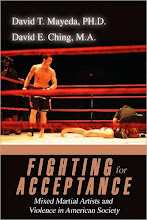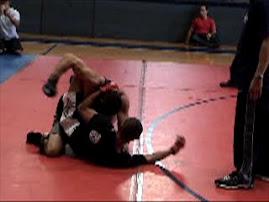
SocProf over at The Global Sociology Blog has motivated me to review some of the ways that sporting violence and masculinity intertwine in contemporary society, resulting in the systemic deterioration of men's health. Indeed the picture displayed, above, is a vivid example illustrating how so many boys are socialized to positively to value violence, both within and beyond sport.
Perhaps the young boys' smile as he watches this hockey fight is the most telling aspect of the picture. However, the picture is of former National Hockey League (NHL) player, Bob Probert, who recently passed away. From The New York Times:
The Fighter: Bob Probert
Bob Probert, who died last summer from heart failure at the age of 45, was notorious for his brutal style of hockey, which included 246 fights with other N.H.L. players over his 16-year career. But these altercations may have also contributed to his chronic traumatic encephalopathy, a degenerative brain disease, which was diagnosed after his death. While the N.H.L. has taken recent steps to reduce brain trauma, it has preserved the league-sanctioned fighting that many argue is part of the sport’s tradition and appeal. Players such as Probert, known as each team’s “enforcer,” continue to be employed, and often admired. The following YouTube videos are a sampling of Probert’s many fights [note: only one shown here].
The entire New York Times story can be read HERE. I would agree that socialization plays a central role in teaching young males over the life course to view engagement into certain types of violence positively. This was a key finding in my interviews with adult mixed martial arts (MMA) fighters, so many of whom grew up watching MMA with key father-figures, fighting with peers, fighting with family, learning to “fight” through wrestling, and so on. Violence in a variety of contexts became a very normalized aspect of their lives.
On the other hand, as Loic Waquant (2001) has noted in his research with boxers in Chicago, males involved in combat sports are not completely blinded by their socialized history to simply engage in sporting violence without thinking to varying degrees about their choices. Rather, boxers – and male athletes in general – are frequently keenly aware of the risks they take, and the ways they may be exploited when making strategic choices to pursue their athletic and occupational goals. Two boxers quoted from Waquant’s study:
All boxers, are what they call, figure of speech: they’re fucked over. You know, you see, they’re pimps, the promoters, you know. And boxers is like the whores, you know, so you pimp him. Yeah, that’s the way that go, I’m pretty sure. They don’t really have the bes’ interes’ in the fighter, you know. They jus’ goin’ for the gusto, the gusto is the money. (dejected but matterof-fact) They jus’ goin’ for the money. (p. 182).
If you go in dere with a nice tough fight, man, rewar’ dis man. I tol’, I saw Highmower fight dis boy, man, man! (chuckle) I hated fightin’, I hated boxin’ ever since, I’m serious. Because, Louie, (incensed) Highmower an’ dat boy nearly killed each other. Man, d’ crowd wen’ crazy, Ralph [the matchmaker] – I’s, I’s like, ‘Look at dis shit!’ Boy, this is slavery all over again. I mean, look at dis shit! Dese men is seriously killin’ each other for (lowering his voice and whispering in joint disbelief and disgust) for a hun’red dollars (stressing each word to dramatize his point) Highmower-cut, that-man-cut, they-all-wen’-down, three-an’-four-time-a-piece. Botha’em wen’ to d’hospital, fer what, fer two hun’red dollars, hun’red each man? I said (shaking his head vigorously), ‘No, that ain’t – tha’s not right.’ (p.183).
Despite having an awareness of their own exploitation, these boxers continued fighting as "flesh peddlers." This is because the individuals weighed the pros and cons that accompanied boxing, making calculated decisions that involved an assessment of their current resources (e.g., time invested in training, dependents, rent to be paid), potential acquisition of additional resources, social status (including the genered social prestige they would gain with victory), and their physical health.
Today, with the emerging research on traumatic brain injury manifesting through sport, there is little doubt that young athletes are aware of the long-term costs that can come with prolonged participation in collision sports. This insightful interview with former professional wrestler and Harvard football player, Christopher Nowwinski on NPR’s Fresh Air speaks to the evolving research that increasingly demonstrates how repeated concussions harm athletes (the entire interview is thought provoking):
Concussions, a type of traumatic brain injury, generally occur when the head either spins rapidly or accelerates quickly and then stops — like when a player tackles another player on the field. The National Football League and Congress have both held hearings on the head injuries, which can cause memory loss, confusion, nausea, blurred vision and long-term neurological effects, including symptoms of dementia, headaches and concentration problems.
The central problem is not that male athletes are unaware of the potential harm that comes with collision sports, or attendant violent sporting activities (namely, fighting). Instead, the problems are:
- Some athletes, in particular those with fewer resources, must make the uneasy choice to sacrifice their long-term physical and mental health for immediate rewards. And for many of these athletes, those immediate financial rewards are not terribly impressive.
- Secondly, male athletes too often view the short-term status increases that accompany participation in violent sport (and fighting) as a positive tradeoff. In other words, male athletes know that by partaking in violent activities (and especially if they win), the public will reward them as males, not only financially, but also through gendered adoration. Sporting violence exalts their public masculinity, if only temporarily.
Both of these social problems can be seen in FX’s recent boxing television series, "Lights Out," where the protagonist boxer must weigh his lost wealth, decreased status, and emerging family crises as he risks his mental and physical health in the ring:
Scholars that examine masculinity and its ties to different types of violence have often argued that men need to see how perpetuation of violent masculinities hurt men (e.g., gun-related homicides happen most commonly among men over slights of disrespect). But what is more critical is that (1) we do not see more vulnerable men with fewer resources seduced into violent sport; and (2) males are not rewarded socially for their violent behaviors.
Changing these two criteria means decreasing social stratification in society so that financially vulnerable men are not disproportionately risking their bodies and minds for sport's very limited rewards, and revamping media that glorifies violent men.
Michelle Martin on “Tell Me More” probably says it in a more profound way:
But it's time to ask whether sports in this country are like oil in the Middle East and Africa. We think sports are making us rich, but are they really making us poor, by keeping us from doing other things that might matter as much or more in the long run? It's an uncomfortable question, but as a fan myself, I have to ask.
Reference:
Wacquant, L. (2001). Whores, Slaves and Stallions: Languages of Exploitation and Accommodation among Boxers. Body & Society, 7 (2/3), 181-194.







good ...... very inspiring .......
ReplyDeletethis information really help me for the future ......
thanks ....... good luck ......
if please visit also my website please ........
thank you........
Obat Untuk Ambeien
Obat Ambeien
Obat Wasir
Penyakit Kutil Di Kelamin
Penyakit Kutil DiKelamin
Penyakit Kelamin Sipilis